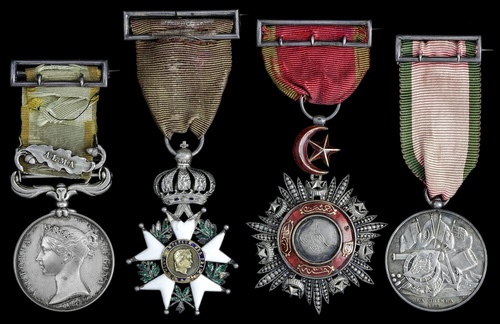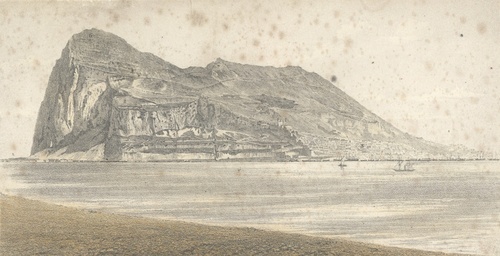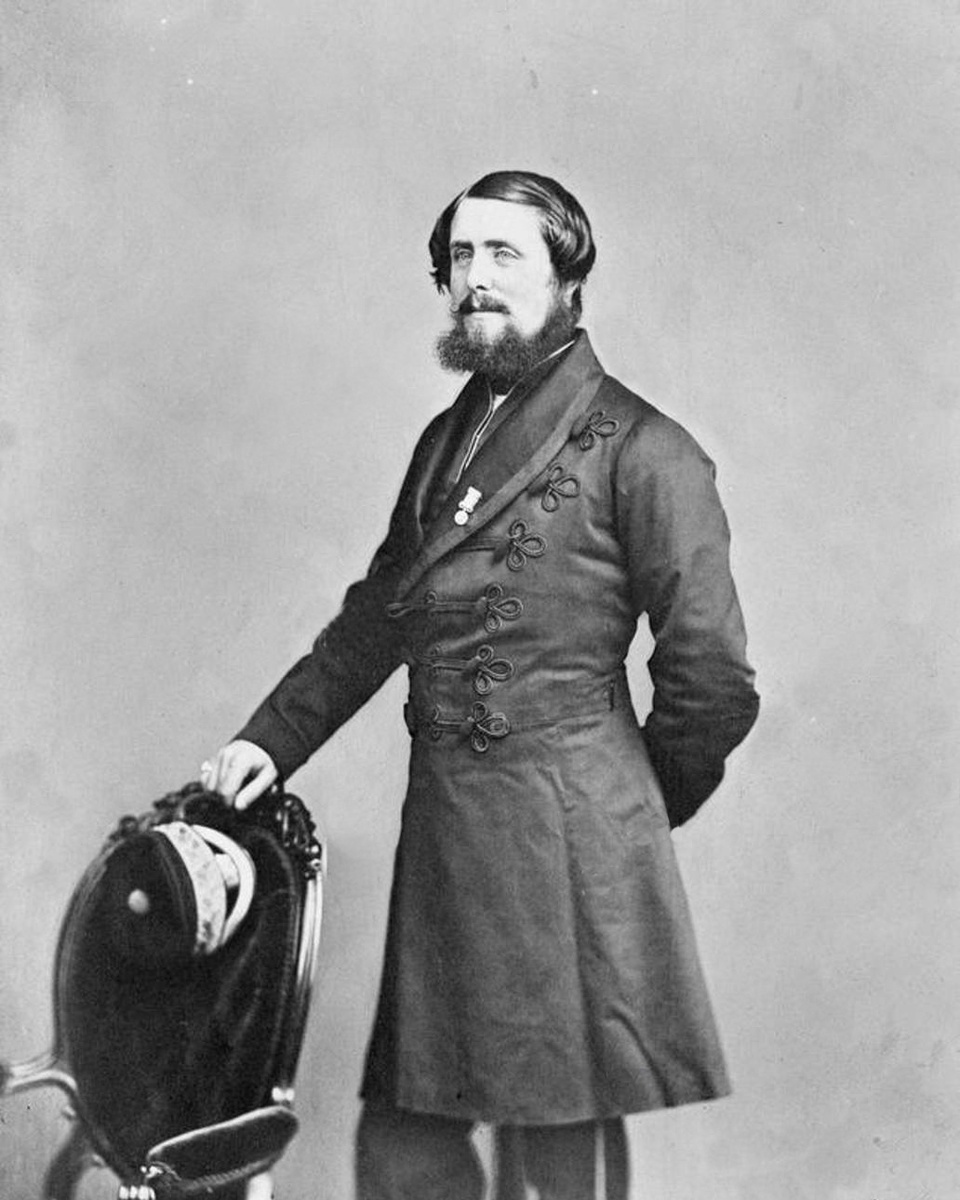Auction: 19001 - Orders, Decorations and Medals
Lot: 368
(x) The important 'Alma casualty's' group of four to Captain Frederick Sayer, 23rd Foot, fêted as the handsomest man in the British Army; renowned for his athleticism, Sayer raced Sir John Dugdale Astley in Windsor Home Park, eagerly watched by the Queen.
Severely wounded while fighting the Vladimir Regiment in the Great Redoubt, Sayer returned to England and received his Crimea Medal from the hand of his ardent admirer, Queen Victoria, in the presentation at Horse Guards Parade on 18 May 1855.
Sayer went on to become Magistrate of Gibraltar and Governor-General of New South Wales. It was while taking up the latter appointment that disease killed him, aged just 36.
Crimea 1854-56, 1 clasp, Alma (Captn. Sayer, Rl. Welch Fusrs.), officially engraved by Hunt & Roskell in large serif capitals; France, Second Empire, Legion of Honour, 5th Class breast Badge, silver, gold centre and enamel; Turkey, Ottoman Empire, Order of the Medjidie, 5th Class breast Badge, silver, gold and enamel; Turkish Crimea, Sardinian issue, privately manufactured by Hunt & Roskell, all mounted on original ribands with Hunt & Roskell silver top riband buckles, the second and third with some enamel loss, very fine or better (4)
Provenance:
DNW, September 1994.
Legion of Honour London Gazette 4 August 1856.
Order of the Medjidie London Gazette 2 March 1858.
Frederick Sayer was born at White Lodge, Sibton, Suffolk on 2 August 1832, the second son of Robert Sayer, a prominent barrister and High Sheriff of Suffolk. He attended Rugby School from 1846, showing early signs of athletic prowess. In 1850 the family moved to the Manor House, Marshgate, Richmond-upon-Thames. On 20 November that year, young Frederick received his Commission as a 2nd Lieutenant in the 23rd Foot (Royal Welch Fusiliers). His portrait in uniform was painted by O. Oakley in February 1851, and later inherited by his grandson William Sayer in South Africa. He was promoted to Lieutenant in September 1852.
In late 1853, Sayer challenged Lieutenant John Dugdale Astley, Scots Fusilier Guards (see previous Lot) to two 150 yard sprints in Windsor Home Park, the first over flat ground and the second with hurdles. Renowned for his good looks, Sayer was already a favourite of Queen Victoria, who watched him eagerly from a balcony on both occasions. As interest in the contest reached fever-pitch, Astley heard a rumour that his opponent had strained his knee. Astley later admitted that: 'A feeling of joy rather than of commiseration pervaded my system' (Astley 1894, 168). Nevertheless visiting Sayer in hospital, he was struck by the physical splendour of reputedly the handsomest man in the Army: 'one of the most perfect models of a well-made man that I ever saw' (Astley 1894, 169). Sayer beat Astley in the first race, and was 3-1 favourite to win the second. Perhaps through overconfidence, Sayer fell at one of the hurdles, leaving Astley as the victor. The two men formed a lasting bond.
With tragic irony, Sayer's athleticism was extinguished at the Battle of the Alma on 20 September 1854. Shortly before 1 p.m., the British infantry were ordered to lie down on the Alma's northern bank while their French counterparts, lagging behind, moved into position on their right. This proved a testing period, as the British were already in range of Russian guns on the southern bank. Lieutenant Morgan of the 95th Foot described 'fragments of shakoes, blankets, clothes and human flesh' being 'carried up in the air' under the intense Russian bombardment (Mercer 1998, 20). At about 2 p.m. Captain Nolan, Raglan's infamous A.D.C., relayed the order for the troops to advance.
The 23rd Foot formed part of Sir George Brown's Light Division, tasked with capturing the Great Redoubt in the centre of the Russian position. Crossing the Alma under heavy fire and then surging up the opposite bank, the Light Division advanced in ragged clusters, prompting a worried Sir Colin Campbell to remark: "My God! Those men are not moving like British soldiers!" (Pemberton 1962, 46). At some points the men were 16 deep, making them highly vulnerable to canister. The 23rd nevertheless reached their objective, Captain Bell scratching '23' on a captured gun barrel with the point of his sword.
Without reinforcements, this advanced position could not be held. Two battalions of the Vladimir Regiment bore down in dense columns. An unidentified staff officer, likely a Russian in disguise, exclaimed: "Don't fire! Don't fire! The column's French!" The 23rd's obedient buglers sounded the 'Cease Fire' followed by 'Retreat', and the hapless 23rd returned down the slope as the Russians reoccupied the Great Redoubt. Shot at from the rear, the Regiment lost 8 officers and 45 other ranks killed, 5 officers and 152 other ranks wounded (Hope 2003, 115). Sayer was shot through the ankle and would never walk, let alone run, again.
While recuperating at Scutari Hospital, Sayer was visited by his old friend Astley, also wounded at the Alma (see Astley 1894, 226). Evacuated home on 28 October, Sayer was to receive his Crimea Medal from the hand of Queen Victoria in the presentation ceremony at Horse Guards Parade on 18 May 1855. The Queen received him warmly as he was wheeled past her in a bath-chair (see Carter 1861, 79). He was still her favourite, and in a letter of 29 January 1856 to King Leopold of Belgium, Victoria expressed her regard for 'that handsome, lame young officer.'
Promoted to Captain on 29 December 1854, Sayer continued to serve as Deputy Assistant Quarter-Master General from August 1855. For his services he was awarded the French Legion of Honour and the Turkish Order of the Medjidie. Now bed-bound, he meticulously compiled and published Despatches and Papers Relative to the Campaign in Turkey (London, Harrison, 1857). Placed on Half Pay on 27 March 1857, he was appointed Magistrate of Gibraltar, a role he embraced. In 1862 he published The History of Gibraltar and of Its Political Relation to Events in Europe (London, Saunders, Ottley & Co.), tracing the Rock's story as far back as the Romans. It is an uncannily prescient tome, which today's politicians might benefit from studying. Extracts include:
'The supposition that if we gave back Gibraltar, Spain would grant us commercial concessions of vast importance, must be regarded simply as an idea suggested by the advocates of surrender. Great Britain would indeed be unmindful of her duty to herself and to Europe were she to give up so important a station to a weak state.' (pp. ix-x)
'General Elliott was prepared for an event which he had long contemplated. For nearly two years he had foreseen this crisis, and had exerted himself, under the oppressive cloud of neglect, to be armed for the occasion. The government, so long deaf to his appeals, had tardily and inadequately reinforced and provisioned the garrison; but the measures were but half-measures, and the fortress was but ill prepared to stand a powerful and lengthy siege.' (p. 283)
'The fiscal policy of Spain, which taught that Gibraltar was a plague-spot upon the commercial prosperity of the country, and the excessive and indeed prohibitive duties levied upon all classes of English manufactures exported from the Rock, soon paralyzed fair and open trading.' (pp. 495-6)
On 29 January 1856 he married Maria H. S. Phipps, the eighteen-year-old daughter of Colonel the Hon. Charles Beaumont Phipps, Keeper of the Queen's Privy Purse. Together they had four sons and four daughters, the first aptly christened Victoria Alma. The wedding took place in St. George's Chapel, Windsor, with Her Majesty and the Prince Consort in attendance.
In 1867, when still under forty, Sayer was appointed Governor-General of New South Wales. Tragically he died in Cairo in February 1868, while on his way to take up his new duties. He was buried at Highgate Cemetery, London. His widow married Lieutenant-Colonel William Chaine M.V.O., 10th Hussars on 4 December 1872. Chaine was Assistant Master of Ceremonies to Queen Victoria, and he became step-father to Frederick Sayer's children.
Sold with a complete archive, including:
(i)
A leather-bound 2nd Edition copy of Frederick Sayer's The History of Gibraltar and of Its Political Relation to Events in Europe (London, Chapman and Hall, 1865), good condition.
(ii)
A folder of research, containing medal rolls, letters and genealogical information about the Sayer family.
Reference works:
Astley, Sir J., Fifty Years of My Life (London, Hurst and Blackett, 1894).
Carter, T., Medals of the British Army, and How They Were Won, Vol. I - Crimea (London, 1861).
Hope, R., A Staffordshire Regiment in the Crimea: 38th Regiment of Foot (Leek, 2003).
Mercer, P., Give Them a Volley and Charge! The Battle of Inkermann, 1854 (Staplehurst, 1998).
Pemberton, W. B., Battles of the Crimean War (London, 1962).
See Lot 613 for the medals to Frederick Sayer's brother, James Robert Steadman Sayer, 1st Dragoon Guards, who led his Regiment with distinction in the Second China War.
See Lot 628 for the rare Egypt Medal with Khedive's Star awarded to Frederick Sayer's son, Frederick Charles Robert Sayer, New South Wales Artillery.
Subject to 5% tax on Hammer Price in addition to 20% VAT on Buyer’s Premium. For more information please view Terms and Conditions for Buyers.
Sold for
£1,800









